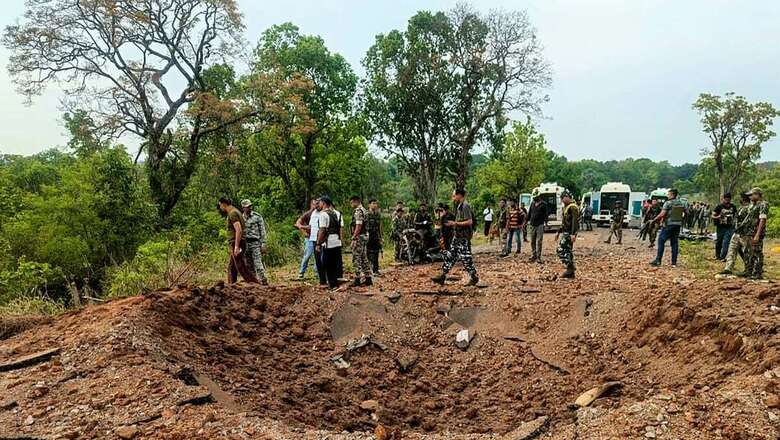
views
The command IED, or wired IED as it is also known, that claimed the lives of 10 policemen and a civilian driver in Dantewada district of Chhattisgarh, was planted by Naxals around two months ago, police said. The modus operandi is the oldest in Naxal playbook to attack security forces. The Bastar region in the state is, in fact, said to be peppered with improvised explosive devices whose locations are known only to the Naxals.
The attack strategy has also been adopted by terrorists in Kashmir to target roads frequently used for movement of security forces.
“Naxals have been carrying out this type of attack since decades. It is easy for them to trigger the IEDs. And with the help of locals, they easily blast any moving vehicle by pressing a button. They place the IEDs at the time of road construction or they dig foxholes,” former DG CRPF Kuldiep Singh told News18.
In the foxhole mechanism, the attackers dig a tunnel in the road to bury the explosives underneath. According to reports, in Wednesday’s attack, the IED was buried three-four feet under the road and could not be detected during demining exercises.
What is a Command IED?
A command or wired IED is rigged to the operator by a wire and is connected to a detonator which is placed at a distance. The blast can be triggered from a safe distance of 200-300 metres to target a moving convoy.
According to Inspector General of Police (Bastar range) Sundarraj P: “Grass had grown on the layer of soil under which the wire connected to the explosive device was concealed… Around 40-50 kg of explosive material was packed in the IED.”
He further said investigation is underway to find out how the IED remained undetected during the demining exercise conduced only a day before.
As per an official police release, the state police’s District Reserve Guards (DRG) personnel from Dantewada and Chhattisgarh Armed Force (CAF) jawans from the Nahadi camp set out for an operation on the intervening night of April 25-26 after learning that Naxals of Darbha division were present in the area.
Around 6:30am the next day, an encounter took place between security personnel and Naxals near Nahadi, following which suspected militia members Lakhma Kawasi (30) and Sanna alias Kosa Madvi (25) were apprehended.
When the duo were being taken back to Dantewada, Naxals detonated the IED near Aranpur around 1pm.
News18 had earlier quoted sources as saying that the Naxals targeted the DRG commandos with the help of locals. Sources had told News18 that the convoy’s first vehicle, which was carrying the arrested Naxals, was given a pass but the second vehicle was flagged down by some locals on the pretext of seeking donations for a local festival. The IED blew up the van around 200 metres from where it was initially stopped by the locals.
Why Do Naxals Use Command IEDs
Naxals are well-trained in guerrilla warfare and the same training is given to those new in the ranks. They avoid direct confrontation with security forces to avoid an encounter which would deplete their numbers.
“Naxals are very different from terrorists. They train their cadre and ensure that they don’t get into a direct encounter with security forces. The command IED attack suits their objectives. It also helps their attempt to snatch weapons from forces after the blast,” Kuldiep Singh told News18.
Explaining further how Naxals operations are different from those carries out by terrorists, the former CRPF DG said: “Terrorists are like jihadis who come and attack forces. They come mentally prepared to be killed as it suits their agenda. Their recruitment levels are very high. But Naxals are different and take care of their cadre. They don’t have the jihadi mentality, but still target forces more often.”
The Naxal strategy, however, has been adopted by terror outfits in Kashmir to an extend as well. It started six years ago when terrorists attempted to attack security forces using a command IED.
Back then, CRPF Director General K Durga Prasad had said: “This is the first time terrorists followed the attack style of the Naxals. There have been IED attacks on security forces and convoys in the past, but using the command-wire technique was unheard of in Kashmir. The technique has been used only by Naxals to target security forces in Left-Wing Extremism- affected areas.”
No Solution to Command IEDs?
Command IEDs are the oldest and most potent weapon in Naxal arsenal, one for which security forces are yet to find a solution. The only counter available at present is the element of surprise in planning operations and troop movement. According to Kuldiep Singh, this has been the go-to attack strategy for Naxals since they started using IEDs.
“It is not humanly possible to detect all IEDs places by Naxals. The only thing is surprise element and secrecy. Forces must not reveal their plan of action to anyone and must add surprise elements to safely operate in Naxal-affected areas. That is the most effective way to deal with such kind of IED attacks,” he said.
Presenting another challenge to security forces is the fact that while they are unable to detect such IEDs, Naxals have a map marked with the exact location of the buried explosives.
In most cases, the area commander of the Naxals carries the maps with him. “There have been cases where vehicles of forces move as usual every day and suddenly, on their way back, security personnel notice a big hole on the road, courtesy a command IED blast. This is a day in the life of a jawan living and fighting in Naxals-affected area,” Singh told News18.
Read all the Latest India News here
















Comments
0 comment